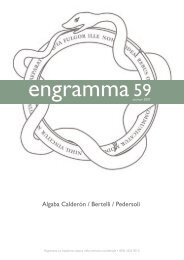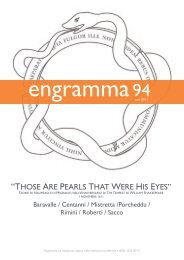Daniela Sacco, Pensiero in azione. Bertolt Brecht ... - Engramma
Daniela Sacco, Pensiero in azione. Bertolt Brecht ... - Engramma
Daniela Sacco, Pensiero in azione. Bertolt Brecht ... - Engramma
Create successful ePaper yourself
Turn your PDF publications into a flip-book with our unique Google optimized e-Paper software.
<strong>Daniela</strong> <strong>Sacco</strong><br />
Qe 03• <strong>Pensiero</strong> <strong>in</strong> <strong>azione</strong><br />
people come together <strong>in</strong> a space which, by the end of the even<strong>in</strong>g, becomes not "my" space or<br />
"your" space, but a shared space where we had a shared experience. Where the borders are<br />
dissolved. Where we truly f<strong>in</strong>d these po<strong>in</strong>ts of shared experience <strong>in</strong> space. For me film doesn't<br />
share space <strong>in</strong> the same way: film has its own space, the audience has its own space; it's really a<br />
mental space, but the actual physical act of shar<strong>in</strong>g a room together is not the same. I th<strong>in</strong>k that<br />
the reason why for me theater has such priority has to do with the land rights of <strong>in</strong>digenous<br />
people, the water rights of <strong>in</strong>digenous people, the fact that aga<strong>in</strong> farmers are committ<strong>in</strong>g suicide<br />
<strong>in</strong> India and <strong>in</strong> Ohio. This question of land and how we share this land and how we treasure it.<br />
The earth isn't just someth<strong>in</strong>g to be divided up and sold, it's sacred. We have to admit the<br />
sacredness of the earth, of the food, of the air, of the water. You can't just buy or sell it. There is<br />
someth<strong>in</strong>g sacred, the water belongs to all of us: when Coca-Cola company buys all the water <strong>in</strong><br />
the world – which is what it is try<strong>in</strong>g to do – we have a crisis. So really this shared space,<br />
rem<strong>in</strong>ds everybody that the earth is sacred, the air is sacred, the water is sacred, the light is<br />
sacred, the plants are sacred, the animals are sacred, that life has a sacred dimension; not <strong>in</strong> the<br />
manner of organized religion but <strong>in</strong> the manner of theater. Where everyth<strong>in</strong>g has its resonance,<br />
its aura, its mistery, its depth. It becomes more touch<strong>in</strong>g, it becomes someth<strong>in</strong>g <strong>in</strong>f<strong>in</strong>ite. We<br />
have a f<strong>in</strong>ite quantity of water, but an <strong>in</strong>f<strong>in</strong>ite level of generosity. Certa<strong>in</strong> th<strong>in</strong>gs are <strong>in</strong>f<strong>in</strong>ite:<br />
love, courage, generosity, honesty. Other th<strong>in</strong>gs are limited: the doma<strong>in</strong> of water, the doma<strong>in</strong> of<br />
land. It's really about understand<strong>in</strong>g how we use the th<strong>in</strong>gs that are <strong>in</strong>f<strong>in</strong>ite, and how we<br />
correctly use the th<strong>in</strong>gs that are f<strong>in</strong>ite. Theater is the meet<strong>in</strong>g place of that <strong>in</strong>f<strong>in</strong>itude and this<br />
specific social limitation which is about shar<strong>in</strong>g. C<strong>in</strong>ema is a great language, I have a great love<br />
of c<strong>in</strong>ema before c<strong>in</strong>ema: Ch<strong>in</strong>ese watercolour pa<strong>in</strong>t<strong>in</strong>g, or traditional Ch<strong>in</strong>ese and Indian<br />
theater, or Javanese shadow puppets, or cave pa<strong>in</strong>t<strong>in</strong>gs. They were all c<strong>in</strong>ema before c<strong>in</strong>ema:<br />
this c<strong>in</strong>ematic impulse is so deep, it doesn't come only from the XIX or XX century, nor do the<br />
ideas of montage and cutt<strong>in</strong>g...<br />
D.S.<br />
Yes, I would like to discuss the importance of montage for you <strong>in</strong> the way you construct theater.<br />
I th<strong>in</strong>k it's really important today, for the theater as well as the c<strong>in</strong>ema. Did you learn about<br />
montage from c<strong>in</strong>ema?<br />
Peter Sellars<br />
Montage is crucial; it's also <strong>in</strong> Sophocles' works. Sophocles always created some episodes that<br />
he then cut and <strong>in</strong> place of those episodes he put the chorus. In Sophocles you can't see simple<br />
real time, because there is a lot that he doesn't show, that he cuts out. He only gives you a very<br />
specific moment <strong>in</strong> time and then he cuts to another moment <strong>in</strong> time and then he puts these two<br />
moments <strong>in</strong> time next to each other. It has an <strong>in</strong>credible emotional impact, precisely because<br />
Sophocles is construct<strong>in</strong>g his pieces, <strong>in</strong> chorus even more so, from these moments <strong>in</strong> time that<br />
normally will not come together, and by putt<strong>in</strong>g them right next to each other, the contrasts are<br />
so <strong>in</strong>tense and extreme that he creates a crisis, but he also creates the deeper th<strong>in</strong>g which is that<br />
everyth<strong>in</strong>g of course is l<strong>in</strong>ked. Montage is simply say<strong>in</strong>g: any two th<strong>in</strong>gs <strong>in</strong> the world are<br />
connected. And we are go<strong>in</strong>g to connect them across this supply and the <strong>in</strong>terconnector is the<br />
poetry: this chair isn't just this chair, this theater isn't just this theater, so noth<strong>in</strong>g is just itself.<br />
Everyth<strong>in</strong>g is itself <strong>in</strong> relation to this question of <strong>in</strong>terrelation and that is where montage is so<br />
excit<strong>in</strong>g, because it really sharpens, and heightens and deepens that sense of relation. When I<br />
was <strong>in</strong> university my obsession and my thesis was about Meyerhold and Ejzenštejn, and the<br />
dawn of c<strong>in</strong>ema. I was <strong>in</strong>fluenced by silent c<strong>in</strong>ema. I really specialized <strong>in</strong> Griffith, early<br />
Hitchcock, Godard, ...but <strong>in</strong> terms of silent c<strong>in</strong>ema, the really great period of my life was <strong>in</strong><br />
Brussels, where <strong>in</strong> my twenties I worked on many projects, and where there was a c<strong>in</strong>emateque<br />
that every night showed two silent movies, with live music. So I lived there. I love the idea of<br />
c<strong>in</strong>ema and live music. In this Godardian way, the soundtrack and the image-track are different:<br />
you have the tension between the soundtrack and the image-track. That's a very satisfy<strong>in</strong>g th<strong>in</strong>g,<br />
55











